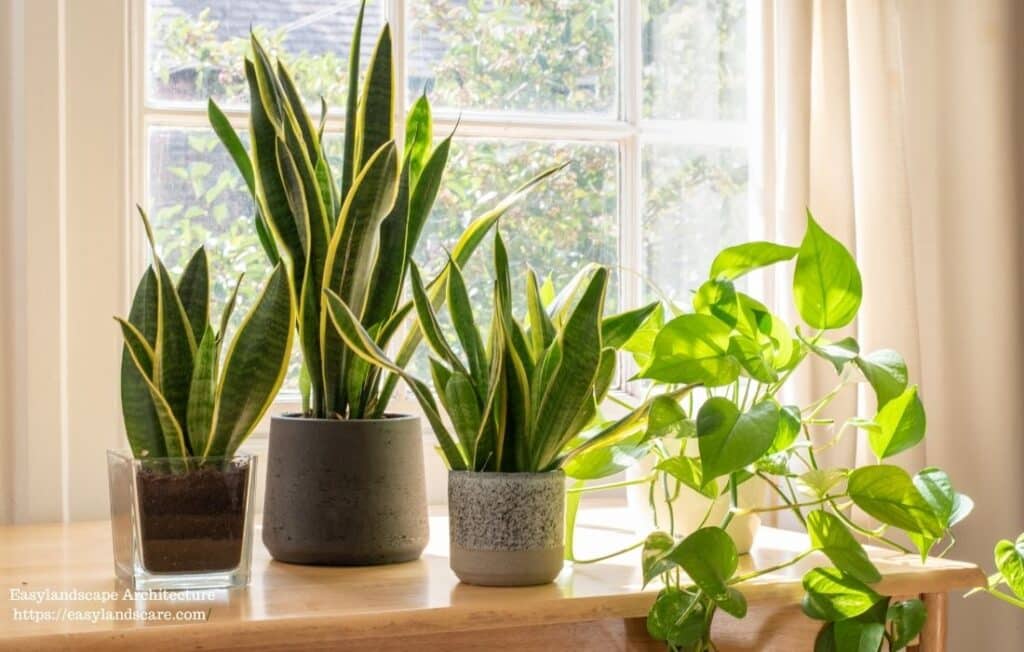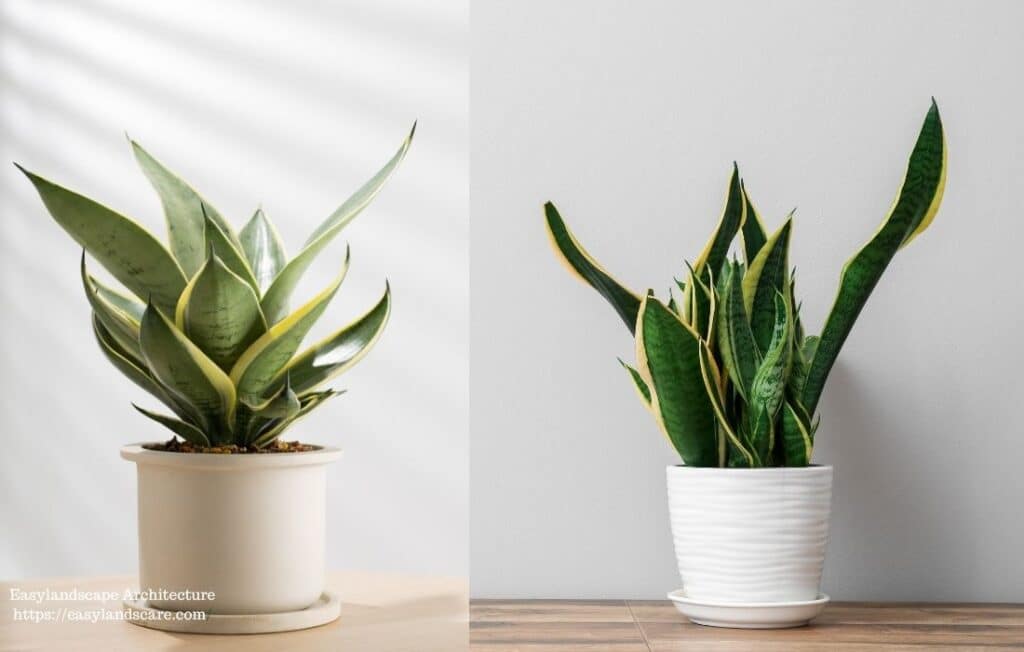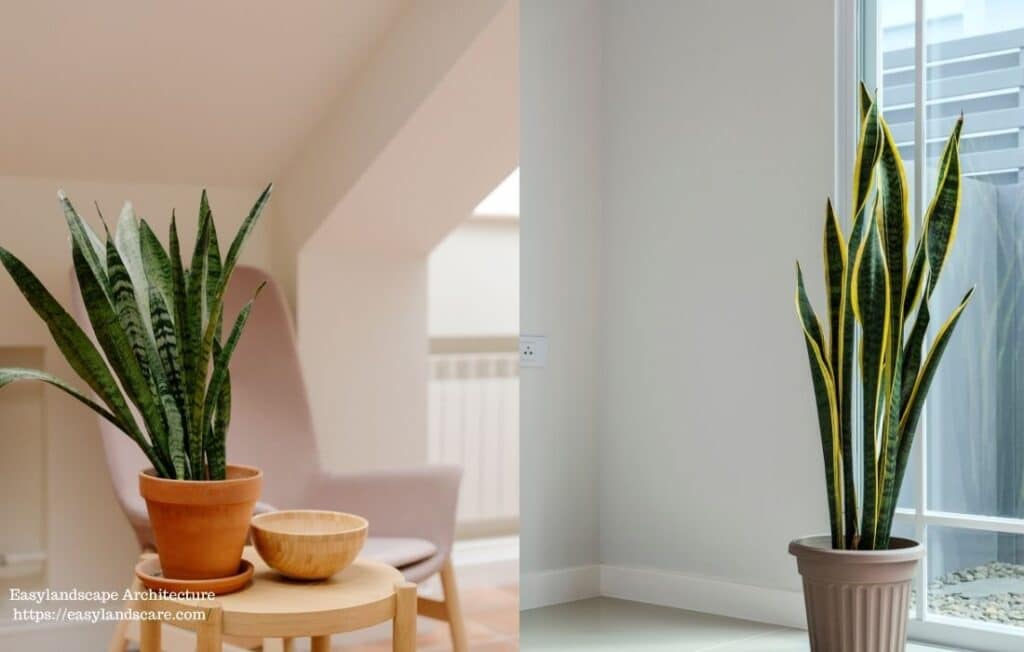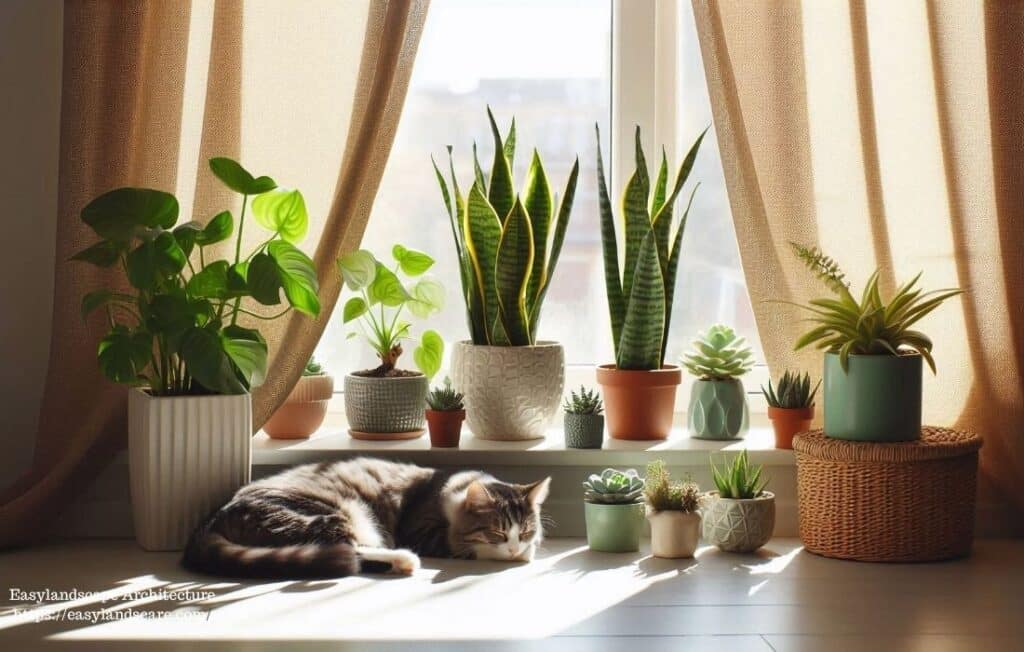Discover the Snake Plant

What are the Snake Plant Benefits? This is a subject that almost everyone who keeps this plant is curious about. The Snake Plant is a very preferred plant species among indoor plants. I think the main reasons for this are that it has durable leaves and is a very good decorative plant. Thanks to these features, we often see this plant especially in offices, restaurants and public areas.
Scientifically known as Dracaena trifasciata (formerly classified under Sansevieria) and commonly called Mother-in-Law’s Tongue, this plant is much more than just a decorative element. Offering a surprising array of benefits, the snake plant has become a favorite among plant lovers. From its potential role in purifying indoor air to its powerful ability to produce oxygen at night to its incredibly easy care, the benefits of the snake plant contribute significantly to creating a healthier, more stylish, and effortlessly green living environment. Let’s take a look at why this hardy snake plant is a preferred choice in almost every interior thanks to its benefits.
Unveiling the Air-Purifying Snake Plant Benefits
One of the most celebrated snake plant benefits is its purported ability to purify indoor air. Modern homes can trap airborne pollutants, known as Volatile Organic Compounds (VOCs), which are released from everyday items. Studies suggest that snake plants can help filter some of these common indoor toxins, showcasing a key aspect of snake plant benefits.
The Science Behind Toxin Removal: A Key Snake Plant Benefit
Understanding where these pollutants come from highlights the potential value of having air-filtering plants. Research indicates that snake plants can be effective against formaldehyde, benzene, xylene, toluene, and trichloroethylene.

Much of the excitement around snake plants and air purification, a significant snake plant benefit, stems from the influential NASA Clean Air Study conducted in 1989. This research aimed to find ways to clean the air in sealed environments like space stations and included Dracaena trifasciata (specifically the ‘Laurentii’ variety) among the plants tested.
The study found that snake plants were effective at removing formaldehyde, benzene, and trichloroethylene from sealed chambers. One specific variety, the Golden Snake Plant, reportedly removed over 50% of pollutants within 24 hours in the test conditions, while the Dwarf Snake Plant variety removed a significant range of toxins daily. Other research, including a study mentioned in the Journal of the American Society for Horticultural Science and work by Orwell et al. (2004), has also supported the plant’s ability to absorb certain VOCs. The mechanism involves pollutants being absorbed through the leaves and roots, where microorganisms in the soil help break them down.
Table 1: Common Indoor Air Pollutants & Their Sources
| Pollutant Name | Potential Health Effects (Examples) | Common Household Sources |
| Formaldehyde | Eye, nose, throat irritation; respiratory issues | Furniture (pressed wood), carpets, paper towels/napkins, grocery bags, adhesives, paints, cleaning products |
| Benzene | Drowsiness, dizziness; linked to leukemia | Plastics, resins, synthetic fibers, detergents, paints, glues, furniture wax, tobacco smoke |
| Xylene | Headache, dizziness, confusion | Paints, lacquers, varnishes, glues, inks, dyes, paint removers, pesticides, cleaners, degreasers, printing |
| Toluene | Nervous system effects, fatigue, confusion | Paints, lacquers, adhesives, paint removers, glues, inks, dyes, nail polish, cleaners, gasoline fumes |
| Trichloroethylene | Dizziness, headache, nausea; potential carcinogen | Printing inks, varnishes, lacquers, adhesives, paint removers, dry cleaning chemicals, metal degreasing |
Understanding the Scope of Air Cleaning Snake Plant Benefits
However, it’s important to place these findings in context when considering the air-purifying snake plant benefits. The NASA study was conducted in small, sealed laboratory chambers, which are very different from typical homes or offices that have regular air exchange with the outdoors. This natural ventilation often removes VOCs much faster and more effectively than plants alone can. Some estimates suggest needing a very large number of plants (potentially 10 to 1000 per square meter of floor space) to match the air cleaning rate of standard building ventilation. Furthermore, later reviews have noted that while the plant’s ability to take up VOCs is clear in lab settings, its impact in complex, real-world environments needs more investigation, and its efficacy might be limited, especially in spaces with high pollution levels.
So, while a snake plant likely won’t single-handedly purify the air in a room, it can certainly be considered a contributing factor to a healthier indoor environment. Think of it as one helpful element in a broader strategy that includes good ventilation and minimizing sources of indoor pollution. Every little bit helps, and the snake plant brings this potential benefit alongside its many others. This aspect is a crucial part of the overall snake plant benefits.
Enhanced Sleep: A Unique Snake Plant Benefit from Nighttime Oxygen
Beyond filtering air, snake plants possess another remarkable trait that sets them apart from most houseplants: they release oxygen at night. This is a significant snake plant benefit for bedrooms. The majority of plants perform gas exchange during the day, taking in carbon dioxide and releasing oxygen through photosynthesis. Snake plants, however, utilize a specialized form of photosynthesis called Crassulacean Acid Metabolism, or CAM.
This isn’t just a random quirk; it’s a clever survival adaptation developed in response to the hot, arid environments of their native West Africa. To conserve precious water during the heat of the day, CAM plants keep their leaf pores (stomata) tightly closed. Then, during the cooler night, they open these stomata to absorb carbon dioxide, storing it chemically as an organic acid. They process this stored CO2 during the following day, releasing oxygen as a byproduct primarily during the night cycle.
This evolutionary strategy for water conservation provides an unexpected perk for indoor environments, adding to the list of snake plant benefits. Because they release oxygen while many people are sleeping, snake plants are often recommended as ideal companions for bedrooms. While the amount of oxygen released might not drastically change the air composition, it contributes to a fresher nighttime atmosphere, potentially enhancing sleep quality. It’s a fascinating example of how a plant’s adaptation to thrive in harsh conditions can translate into a welcome snake plant benefit within the home.
The Effortless Greenery: Low-Maintenance Snake Plant Benefits
Snake Plants Are Perfect for Beginners and Busy Lifestyles
Perhaps one of the most compelling snake plant benefits, especially for those new to plant care or with busy lifestyles, is its incredible ease of maintenance. These plants are renowned for their hardiness and resilience, thriving on a level of neglect that would spell disaster for more finicky species. They are often described as “tough-as-nails” and are forgiving of occasional forgetfulness.
Adaptability to Various Lighting Conditions
A key factor in their easy-care nature, a core snake plant benefit, is their tolerance for a wide range of conditions. They are particularly noted for their ability to handle low light. While they grow best and display the most vibrant colors in bright, indirect sunlight, they can survive and maintain their appearance in shadier corners of a home or office where other plants might struggle. However, placing them in a completely windowless room long-term is not recommended, as some light is still necessary for photosynthesis.
Exceptional Drought Tolerance
Equally important is their exceptional drought tolerance. Thanks to their thick, water-storing leaves (often protected by a waxy coating) and their water-saving CAM photosynthesis process, snake plants require infrequent watering. In fact, the most common mistake made in snake plant care is overwatering, which can quickly lead to root rot, a fatal condition for these succulents. Signs of overwatering include drooping or yellowing leaves and brown, mushy roots. The key is to let the soil dry out completely between waterings.
Finding the Right Balance in Snake Plant Care
Understanding the plant’s resilience is crucial for proper care. Its hardiness might lead some to believe it needs virtually no attention, potentially resulting in severe underwatering (indicated by wrinkled leaves). Conversely, well-intentioned plant parents might overcompensate with water, unaware of its drought-adapted nature. Finding the right balance – providing adequate light (even if indirect) and watering thoroughly only when the soil is completely dry – is the secret to success and enjoying these snake plant benefits.
Table 2: Snake Plant Care Essentials

| Care Aspect | Requirements | Notes |
| Light | Prefers bright, indirect light; Tolerates low light conditions | Growth is slower in low light; Avoid prolonged direct sun which can scorch leaves. |
| Watering | Allow soil to dry out completely between waterings; Water thoroughly every 2-8 weeks depending on light, temperature, and season | Reduce frequency significantly in winter. Ensure pot has drainage holes to prevent root rot. |
| Temperature | Ideal range is 60°F to 80°F (16°C to 27°C) | Avoid temperatures below 50°F (10°C) and cold drafts. |
| Soil | Requires a well-draining potting mix; Cactus or succulent soil is ideal | Good drainage is critical to prevent waterlogging. |
| Fertilizer | Generally not necessary; Can apply a diluted, balanced fertilizer once during the spring growing season if desired | Avoid fertilizing in fall/winter. Over-fertilizing can harm the plant. |
| Humidity | Adaptable to average household humidity (around 40%); Tolerates both dry and humid conditions | Misting is not required. |
For a more detailed snake plant care guide, we recommend you read our article “Snake Plant Care: Simple Effective Tips for Happy Plants“.
Beyond the Basics: Wellness and Ambiance Snake Plant Benefits
Beyond the tangible benefits of air filtration and easy care, bringing plants like the snake plant indoors can positively impact overall well-being and the ambiance of a space. These broader snake plant benefits contribute to a holistically healthier environment.
Mental Well-being and Productivity: Subtle Snake Plant Benefits
Studies suggest that the presence of indoor plants can enhance mental health by reducing stress, boosting mood, and even increasing focus and productivity. Having a snake plant in a workspace or living area can contribute to a more pleasant, calming, and efficient environment, another of the valuable snake plant benefits.
Humidity Regulation and Allergen Reduction: More Snake Plant Benefits
Snake plants also contribute subtly to physical comfort by regulating indoor humidity. Through transpiration, they release water vapor into the air, which can be particularly beneficial in dry climates or during winter months when heating systems reduce air moisture. Maintaining adequate humidity can help alleviate issues like dry skin and respiratory discomfort. Some sources also suggest that by releasing moisture and oxygen, air-purifying plants may help reduce the impact of airborne allergens like dust and dander, adding to the list of potential snake plant benefits, although more specific research may be needed.
In Feng Shui, the traditional Chinese practice of creating harmony through space arrangement, the snake plant symbolizes good fortune. It’s believed to bring protective energy, good fortune, and positivity into the household.
Ultimately, the value of a snake plant often lies in this holistic contribution. It’s not just one single feature, but the combination of its air-purifying potential, its nighttime oxygen release, its visual appeal, its ease of care, and these subtle wellness and atmospheric enhancements that make it such a beneficial addition to the home. It connects occupants with a touch of nature, offers a grounding element of care (however minimal), and improves the overall feel of a space in multiple ways. These comprehensive snake plant benefits make it a truly rewarding houseplant.
Aesthetic Appeal: The Stylish Snake Plant Benefits for Decor
Let’s not forget the visual appeal! Snake plants are undeniably stylish, a snake plant benefit that enhances any interior. Their characteristic tall, upright, sword-like leaves possess a strong architectural quality that complements a wide range of interior design styles, from minimalist and modern to bohemian and traditional. Their clean lines and often striking patterns make them effective focal points or sophisticated background greenery. They are incredibly versatile in placement, working well as floor plants when mature, or adding vertical interest to shelves, desks, and tabletops.

A common misconception might be that all snake plants look the same, likely picturing the popular ‘Laurentii’ variety. However, the Dracaena genus boasts over 70 species formerly classified as Sansevieria, leading to a surprising diversity in appearance. This variety means homeowners can select a snake plant that perfectly matches their aesthetic preferences and space constraints, maximizing the decorative snake plant benefits. From tall and slender to short and stout, with flat or cylindrical leaves, and showcasing colors ranging from deep greens and silvers to yellows and creams, there’s a snake plant for nearly every taste. This diversity elevates the snake plant from a merely functional houseplant to a deliberate design choice.
Table 3: Popular Snake Plant Varieties for Your Home
| Variety Name | Key Features/Appearance | Typical Indoor Size (Approx.) | Notes |
| ‘Laurentii’ | Tall, flat leaves; Dark green center with distinct bright yellow edges | Up to 3-4 feet tall | The classic, most recognizable variety. |
| ‘Zeylanica’ | Tall, flat leaves; Wavy horizontal stripes of dark and light green; No yellow edges | Up to 2-3 feet tall | Similar shape to ‘Laurentii’ but with all-green patterning. |
| ‘Moonshine’ | Broad, upright leaves; Ethereal silvery-green color | Up to 2 feet tall | Needs brighter light to maintain silver color. |
| Cylindrical (e.g., ‘Fernwood Mikado’, ‘Starfish’) | Slender, rounded, upright or arching leaves; Often banded | Varies (e.g., Mikado ~3 ft , Starfish ~4ft ) | Unique, modern architectural look; ‘Starfish’ fans out. |
| ‘Hahnii’ (Bird’s Nest) | Short, compact rosette shape; Leaves grow outwards like a nest | Around 6-8 inches tall | Ideal for small spaces; ‘Golden Hahnii’ has yellow stripes. |
Important Considerations: Toxicity to Pets and Children
While snake plant benefits are numerous for humans, it’s crucial to be aware of their potential danger to household pets and small children. The leaves and roots contain compounds called saponins, which are toxic if ingested. According to the ASPCA and other sources, consuming parts of the snake plant can cause symptoms like nausea, vomiting, diarrhea, and excessive salivation in cats and dogs. While generally considered mildly toxic, it’s best to err on the side of caution.

To safely enjoy snake plants in a home with pets or curious toddlers, place them on high shelves, use plant hangers, or keep them in rooms that pets and children cannot access unsupervised. Promoting the advantages of any houseplant comes with the responsibility of highlighting potential risks, ensuring everyone can make informed choices for their home environment.
Maximizing Your Snake Plant Benefits: A Summary
The Snake Plant has earned its enduring popularity. It’s a botanical powerhouse that offers a remarkable combination of potential snake plant benefits. While its air-purifying capabilities should be viewed realistically as a contribution rather than a cure-all, its scientifically backed ability to release oxygen at night makes it a unique addition, especially for bedrooms. Add to this its incredible resilience and low-maintenance needs, making it accessible to everyone, regardless of their gardening experience, further enhancing the practical snake plant benefits.
Beyond these practical advantages, the snake plant enhances indoor ambiance, potentially boosting mood and well-being, while its diverse forms offer stylish options for any décor. It’s a plant that gives back generously for minimal effort. As long as precautions are taken regarding its toxicity to pets and children, the snake plant stands out as a rewarding, multifaceted, and beneficial addition to virtually any home or office. Consider exploring the different varieties available – the perfect snake plant to enhance your space and deliver numerous snake plant benefits might be waiting.
References
- ASPCA. (n.d.). Toxic and Non-Toxic Plants List.
- Bringslimark, T., Hartig, T., & Patil, G. G. (2009). Psychological benefits of indoor plants in workplaces: Putting experimental results into context. HortScience, 44(1), 258-264.
- Chen et al. (2002).
- Fjeld, T. (2000).
- Liu et al. (2022).
- Lohr, V. I., & Pearson-Mims, C. H. (2000).
- Orwell, R. L., Wood, R. L., Burchett, M. D., Tarran, J., & Torpy, F. (2004). The potted-plant microcosm for removal of volatile organic compounds from indoor air. Water, Air, & Soil Pollution, 157(1-4), 193-207.
- Sriprapat, W., & Thiravetyan, P. (2013).
- Torpy, F. R., Irga, P. J., Brennan, J., & Burchett, M. D. (2014). Testing the single-pass VOC removal efficiency of an active green wall using methyl ethyl ketone (MEK). Air Quality, Atmosphere & Health, 7(3), 325-331.
- Wolverton, B. C., Johnson, A., & Bounds, K. (1989). Interior landscape plants for indoor air pollution abatement. NASA-TM-101766.





